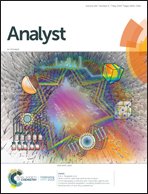An implanted pH sensor read using radiography†
Abstract
A biomedical sensor was developed to measure local pH near orthopedic implants to detect and study implant-associated infection. The sensor is read using plain radiography, a technique which is noninvasive, inexpensive, ubiquitously available in medical facilities, and routinely used in diagnosis and follow-up. The sensor comprises a radiopaque tungsten indicator pin embedded within a chemically responsive hydrogel that exhibits a pH-dependent swelling. A stainless steel well holds this hydrogel and attaches to an orthopedic plate. The local pH may be determined from the extent of hydrogel swelling by radiographically measuring the indicator position relative to the well. We calibrated the sensor in a series of standard pH buffers and tested it during bacterial growth in culture. The sensor was robust: its response was negligibly affected by changes in temperature, ionic strength within the normal physiological range, or long-term incubation with reactive oxygen species generated from hydrogen peroxide and copper. Pooled data from several sensors fabricated at different times and tested in different conditions had a root-mean-square deviation from a pH electrode reading of 0.24 pH units. Radiographic measurements were also performed in cadaveric tissue with the sensor attached to an orthopedic plate fixed to a tibia. Pin position readings varied by 100 μm between observers surveying the same radiographs, corresponding to 0.065 pH units precision in the range pH 4–8. The sensor was designed to augment standard radiographs of tissue, bony anatomy, and hardware by also indicating local chemical concentrations.



 Please wait while we load your content...
Please wait while we load your content...